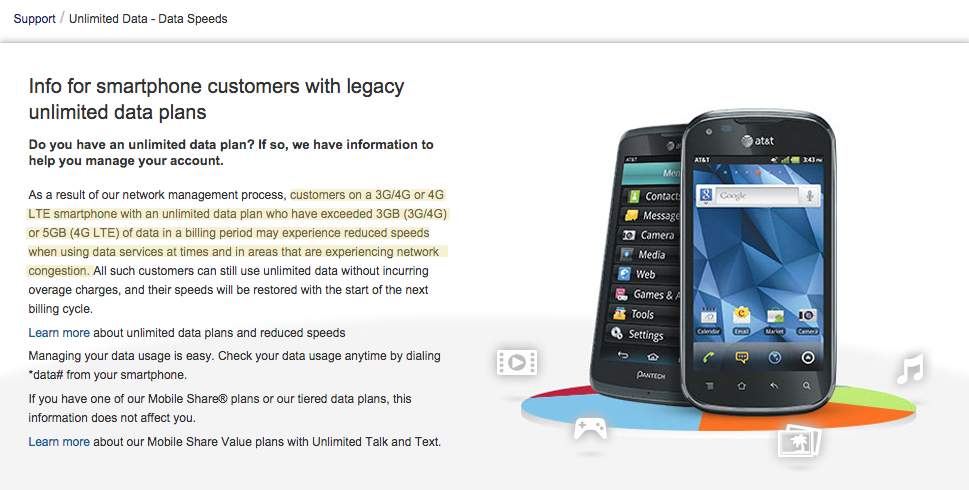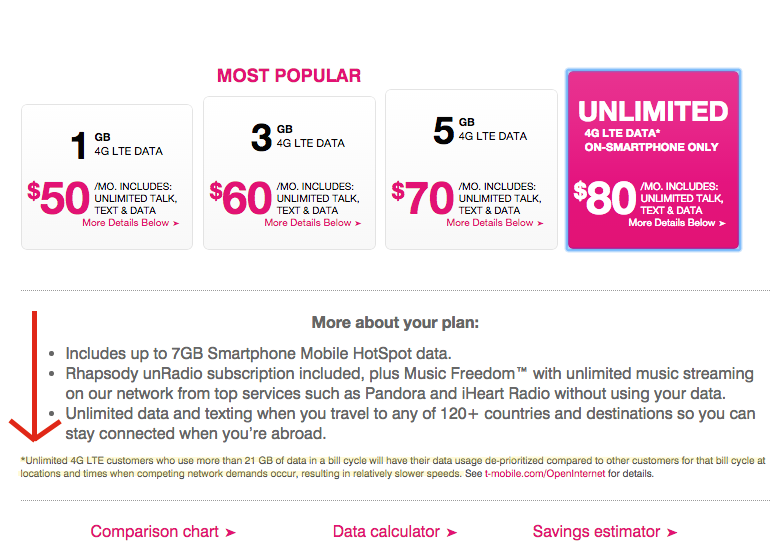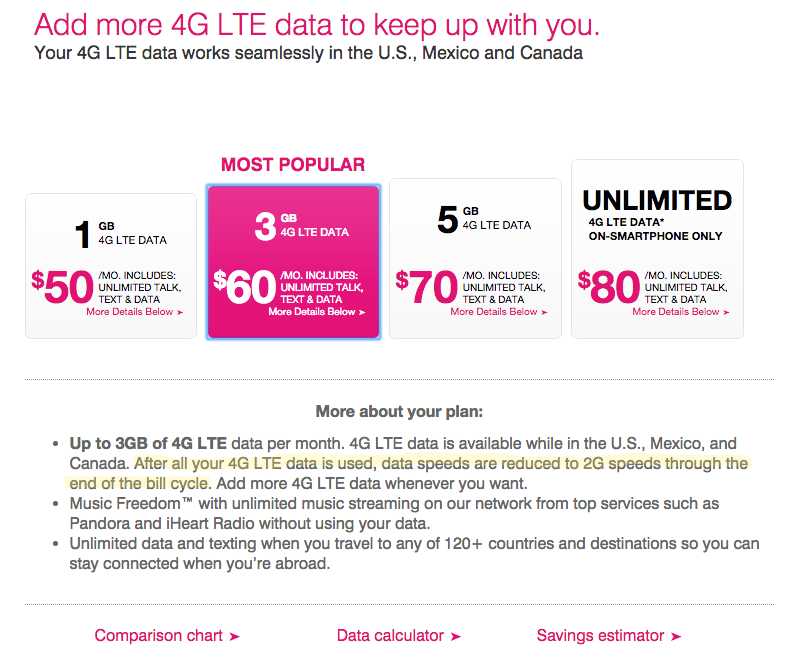Questions to Carriers: What is Throttling?

Throttling has been a hot topic in the news as of late. Thanks to the announcement of a major fine by the US Federal Communications Commission (FCC) against AT&T, throttling, a word we previously associated with our car engines, has taken on a new meaning that impacts our mobile data speeds.

Throttling: the process of reducing data speed, usually after a particular threshold of usage is reached.
AT&T was hit with fines reaching $100M after the FCC released a report stating:
...AT&T failed to disclose that unlimited-data-plan customers could have their data speeds reduced temporarily as part of the company’s approach to managing network
congestion.
So what is throttling exactly? Why do carriers do it? And how are we as consumers supposed to know when it happens?
This week, Questions to Carriers seeks to explain what throttling does to your data and if, in fact, your carrier throttles.
The FCC’s 2010 Open Internet Order states every American has the right to access robust high-speed Internet service, known as broadband, to utilize technology and improve lives. Within that order the FCC implemented the “Transparency Rule”, which sets forth the right to accurate information. In the case of the AT&T fine, the meaning of the “Transparency Rule” within the order became very important:
The Rule requires that what providers tell you about their broadband service is sufficient for you to make informed choices – including choices about speed and price.
The above quote gave the FCC the power to question the transparency of marketing information wireless carriers provided about mobile data speeds, which helped begin a probe into throttling. Later the FCC enacted a revision to the Open Internet Order, which went into effect June 12, 2015. But it was AT&T’s implementation of a “maximum bit rate” (MBR) policy in 2011 which caused the FCC to further question the carrier under the Transparency Rule. After diving deeper into AT&T’s practices the FCC found:
Customers who were subject to the MBR policy had their speeds reduced for an average of 12 days per billing cycle.
So exactly what was AT&T actually doing?
If you recall, at one point all the big US carriers, including AT&T, offered “unlimited” data plans. AT&T did away with those plans in 2010. When the decision was made, AT&T put monthly data limits in place, transitioning consumers to capped data plans with overage charges. But previous unlimited plan customers were “grandfathered” into keeping their (supposedly) all-you-can-eat data plans.
Almost immediately after the transition was made at AT&T, the FCC began receiving complaints about slow internet speeds on the AT&T network. Now over four years later, the FCC is fining AT&T on grounds that it did not inform its grandfathered customers that they would receive slower data speeds or “be throttled” once they hit a certain threshold of gigabytes used.
As you already know from previous blog posts, data usage continues to rise. Back in 2007, when you signed up for AT&T to be the first one of your friends with an iPhone, you weren’t worried about data. “Give me talk and text, that’s all I care about!” Or so you thought at the time. Most of us weren’t spending a ton of time browsing the internet on the relatively primitive devices of the time.

But now basically everything we do on our mobile devices uses data. The entrance of smartphones evoked a new demand for broadband as we transition away from worrying about minutes and messages.
With so many people using more and more data, carriers should have invested in upgrading to better networks to satisfy demand right? Instead carriers took the easy way out: they bumped people down to lower speeds, aka throttled them, to reduce the strain on the network.

Now that you understand throttling, how are you supposed to know when it happens? Well the FCC is working hard to make sure carriers are more transparent. But in the meantime, we dove into the big four’s tiny fine print to figure out if and when you will see lower speeds.
AT&T
Updates to AT&T’s plans no longer indicate throttling at a certain threshold of data usage. Instead users face the threat of heavy overages. Although for grandfathered unlimited plan holders throttling still applies.
If you're on a grandfathered unlimited 3G or 4G plan, you're throttled after 3GB of use.
If you're on a grandfathered unlimited 4G LTE plan, you're throttled after 5GB of use.

As you can see, neither grandfathered plan limitation specifies the speed users will be downgraded to.
Verizon
According to amendments to their policies Verizon does not throttle. This is mostly because the carrier already made a serious push for grandfathered unlimited plan holders to sign new contracts a few years back, although there are a couple loopholes.
Previously they had stated:
Beginning in 2011, to optimize our network, we managed data connection speeds for a small subset of customers - those who are in the top 5% of data users and have 3G devices on unlimited data plans - and only in places and at times when the network was experiencing high demand. We discontinued this practice in June, 2015.
The carrier did try to implement throttling policies on their 4G LTE unlimited customers, but after aggressive questioning by FCC commissioner Tom Wheeler, Verizon had a change of heart.
T-Mobile
Dubbed “de-prioritized” rather than “throttled” in T-Mobile’s fine print, the company recently updated their data speed reduction policy as well.
For the $80 unlimited plan users are de-prioritized after 21GB of use.

For all other plans, users are "de-prioritized" to 2G speeds after they have used their specified data allotment.

Sprint
Previously known for throttling speeds for the top 5% of data users, Sprint changed their policy in the days after the FCC’s fine against AT&T.
Following Sprint’s policy change, the carrier unveiled a new “All In” unlimited plan that would throttle video streaming down to 600 kbps. The implementation of the new unlimited plan was met by an outcry from angry consumers, which ultimately led Sprint to remove the video throttling after stating:
At Sprint, we strive to provide customers a great experience when using our network. We heard you loud and clear, and we are removing the 600 kbps limitation on streaming video.
Which was followed by another vague statement regarding throttling:
During certain times, like other wireless carriers, we might have to manage the network in order to reduce congestion and provide a better customer experience for the majority of our customers.
Verizon, T-Mobile and Sprint all made quick changes after seeing the fines AT&T accrued, but that isn’t to say fines aren’t on the way for the other carriers as well. The FCC will continue to investigate throttling in the coming months and heavily monitor US mobile carriers under the revised Open Internet Order.
Blocking, throttling, fast lanes & other efforts to come between consumers and the Internet should now be things of the past. #OpenInternet
— Tom Wheeler (@TomWheelerFCC) June 11, 2015